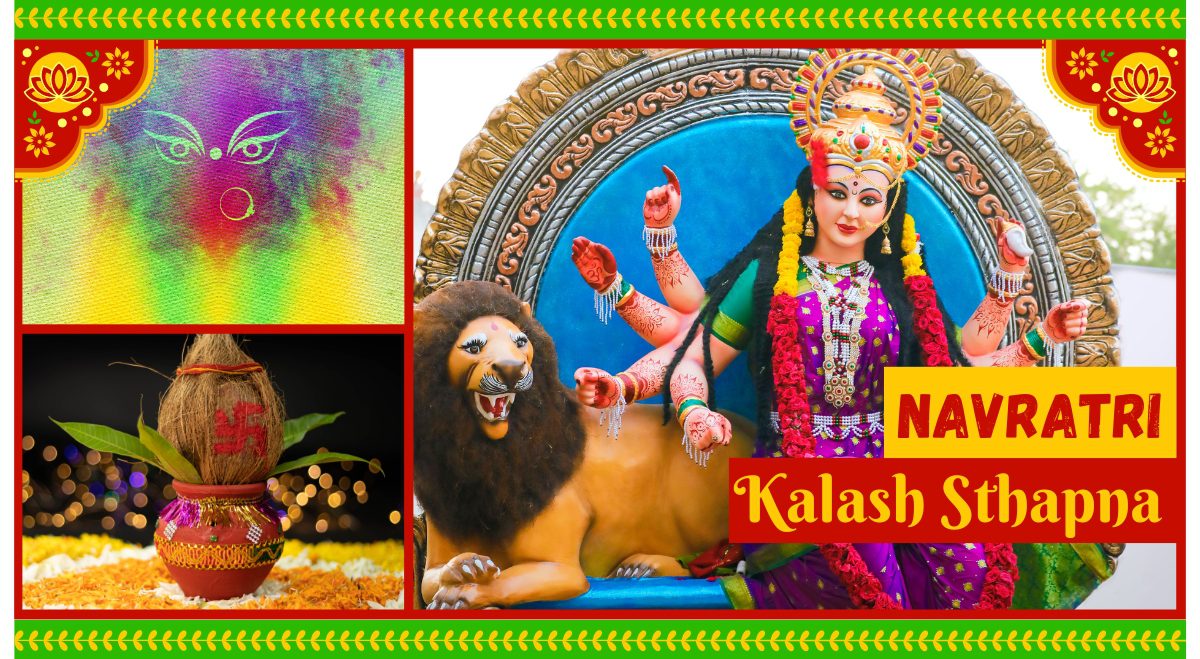Navratri, the nine-night festival celebrating the divine feminine, begins with the sacred ritual of Ghatasthapana. This auspicious ceremony invokes Goddess Durga’s presence and sets the tone for the entire festival. Whether you’re a seasoned practitioner or new to the tradition, this guide will walk you through the process of performing Ghatasthapana at home.
Understanding Ghatasthapana
Ghatasthapana, also known as Kalash Sthapana, is the ritual of establishing a sacred pot or kalash that symbolizes the goddess. It’s performed on the first day of Navratri, marking the beginning of the festivities.
Preparing for the Ritual: Essential Items (Puja Samagri)
Gather the following items before beginning the ritual:
- Wide-mouthed clay pot for sowing grains
- Small clay or brass pitcher (Kalash)
- Clean soil
- Seven types of grains (Sapta Dhanya)
- Sacred thread (Moli or Kalaya)
- Ganga Jal (holy water)
- Betel nuts (Supari)
- Coins
- Five leaves of Ashoka or Mango tree
- Unpeeled coconut
- Red cloth
- Flowers and garlands (preferably marigold)
- Durva grass
- Incense sticks and lamp (diya)
- Picture or idol of Goddess Durga
Step-by-Step Ghatasthapana Puja Process
Preparing the Sacred Space
Clean and purify the area where you’ll perform the puja. Take a bath and wear clean clothes before beginning the ritual.
Setting Up the Clay Pot
Take the wide-mouthed clay pot and spread a layer of clean soil in it.
- Sow the seven types of grains (Sapta Dhanya) over this layer.
- Add a second layer of soil, spreading more grains near the pot’s edges.
- Add a final layer of soil on top.
- Sprinkle some water to moisten the soil.
Preparing the Kalash
- Tie a sacred thread around the neck of the Kalash.
- Fill it with holy water up to the neck.
- Add betel nuts, scent, Durva grass, unbroken rice (Akshat), and coins to the water.
- Place five Ashoka or mango leaves at the edge of the Kalash.
- Cover the Kalash with a lid.
Assembling the Kalash
- Take an unpeeled coconut and wrap it in red cloth.
- Secure the wrapped coconut with a sacred thread.
- Place this coconut on top of the prepared Kalash.
Final Setup
Position the Kalash in the center of the grain-filled clay pot.
Invoking the Goddess
With sincere devotion, request Goddess Durga to accept your prayers and reside in the Kalash for the nine days of Navratri.
Offering Prayers
Perform the Panchopachara Puja:
- Show a lamp to the Kalash and all invoked deities
- Offer lit incense sticks (Dhoop)
- Present flowers and scent
- Offer Naivedhya (fruits and sweets)
Symbolism and Significance
Each element in the Ghatasthapana ritual carries deep symbolic meaning:
- The Kalash represents the universe and the divine mother.
- The coconut symbolizes the divine consciousness.
- The seven grains signify prosperity and growth.
- The red cloth represents the power of the goddess.
Do’s and Don’ts
Do’s:
- Perform the ritual with a pure heart and sincere devotion.
- Maintain cleanliness in the puja area throughout Navratri.
- Offer fresh flowers daily to the Kalash.
Don’ts:
- Avoid performing Ghatasthapana during Amavasya or at night.
- Don’t let the soil in the pot dry out completely.
Conclusion
Performing Ghatasthapana is a beautiful way to begin your Navratri celebrations. By following these steps and understanding the significance behind each action, you can create a meaningful connection with the divine and invite Goddess Durga’s blessings into your home. Remember, the most important aspect is your sincere devotion and intention.
As you embark on this spiritual journey, may the divine mother’s grace fill your life with joy, strength, and prosperity. Happy Navratri!

